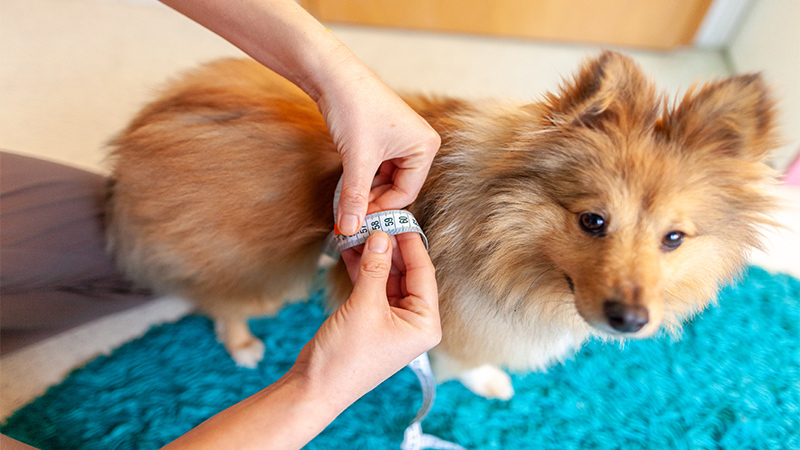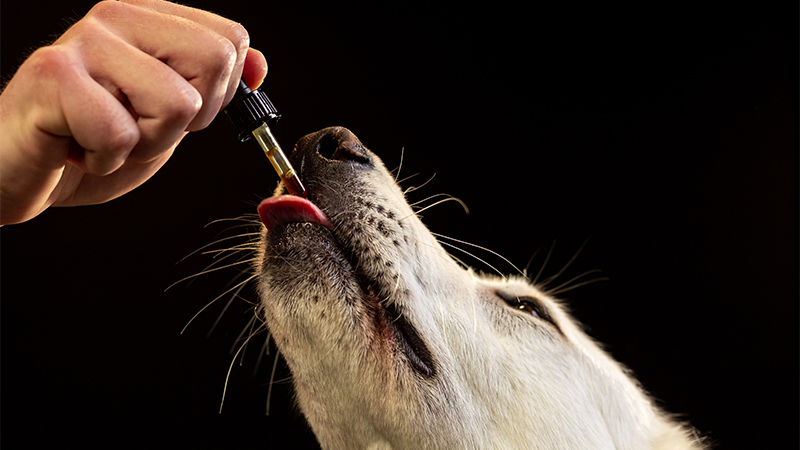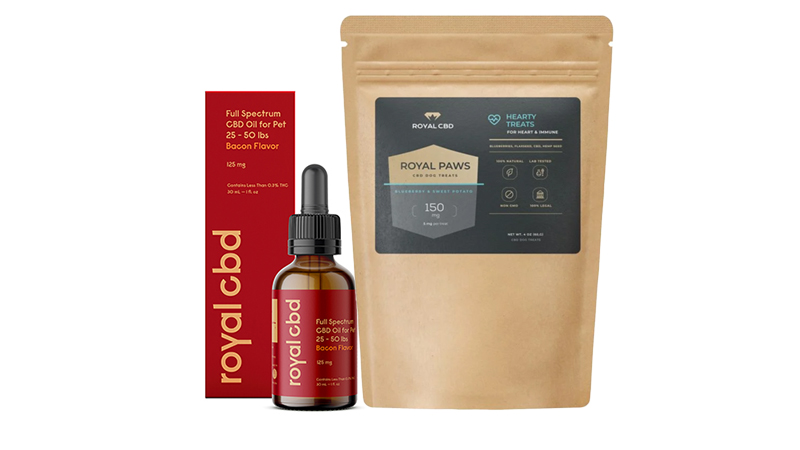CBD Oil for Dogs with Diabetes – Does It Help Diabetic Pets?

Does your dog have diabetes?
While the diagnosis may sound frightening, there are several ways you can successfully manage the condition with.
Such as CBD oil, for example.
You may have heard that CBD can help regulate metabolic health and protect against the damage caused by chronic conditions.
Well, these aren’t just rumors.
In fact, there’s a solid piece of scientific evidence suggesting that CBD and other cannabinoids can be useful for managing diabetes, both in animals and in humans.
Here’s everything you need to know about giving your dog CBD oil for diabetes.
What is Diabetes?
One simply can’t understand how diabetes works without realizing the mechanisms and importance of insulin in the body.
Insulin is a metabolic hormone that plays a critical role in regulating how our body processes energy from the food we eat.
In healthy animals, insulin is released by the pancreas after a meal, communicating with cells around the body and telling them to start absorbing sugar (glucose) from the blood and using it to fuel their energy.
Every time too much glucose builds up in the body, insulin signals cells to store it in the liver for later.
Insulin also enables the absorption of amino and fatty acids after the digestion of proteins and fats. Lastly, it helps regulate the release of glucose from the liver into the bloodstream.
If your dog’s body stops — or slows down — the production of insulin, it’s probably the result of diabetes.
Types of Diabetes
Diabetes has two main categories that can affect dogs:
- Insulin-Deficiency Diabetes (Type 1): This type of diabetes gets triggered when your dog’s body doesn’t release enough insulin. It usually occurs as a result of some kind of issue in the pancreas keeping it from working correctly. That’s the most common type of diabetes in dogs and needs to be managed with daily insulin shots for the most time.
- Insulin-Resistance Diabetes (Type 2): Insulin-resistance diabetes is an acquired condition that involves a flawed response to insulin from the cells in the body. As a result, the cells can’t absorb glucose from the blood — causing it to circulate. It happens more often in older, obese dogs, although female dogs are prone to developing temporary insulin-resistance diabetes when pregnant or shortly after giving birth.
But how do you know that your dog has diabetes?
Alarming Signs That Your Dog May Have Diabetes

If you suspect your dog might have diabetes, it’s important to catch the early signs.
There are three common signs of diabetes in dogs:
- Increased Thirst: Abnormal thirst and increased appetite is something to watch out for because it might indicate problems with glucose absorption and electrolyte disturbances.
- Weight Loss: Dogs with diabetes may start losing weight even though their eating patterns and exercise habits don’t change. That’s caused by their body being unable to absorb and convert nutrients from food into energy.
- Frequent Urination: This is a common response of the dog’s body to excess glucose in the blood. The body will try to get rid of this excess by uptaking more fluids and urinating more often. You might notice your dog asking to be let out more often or soiling the house.
Advanced cases of diabetes are also characterized by lethargy, loss of appetite, vomiting, depression, hypertension, and secondary infections.
What Are the Risk Factors of Canine Diabetes?
There are several factors that can increase the risk of diabetes in your dog, including:
- Diet: Diet can be responsible for a bulk of diabetic cases in dogs; it can also cause a range of other problems that can increase the risk of diabetes. Dogs who eat high amounts of foods rich in starch, carbohydrates, and trans-fats are at risk of developing pancreatitis. Your dog’s diet should contain at least 30% protein and little to no carbohydrates at all.
- Weight: Being overweight may cause insulin resistance in your dog’s cells, increasing the chances of developing type 2 diabetes.
- Pancreatitis: Inflammation of pancreatitis puts your dog in a high-risk group of developing type 1 diabetes.
- Genetics: Certain breeds are genetically predisposed to diabetes. Dogs whose parents had diabetes are also more likely to develop the condition themselves. Breeds that are at risk of developing diabetes include Schnauzers, Pugs, Pulis, Fox and Carin Terriers, Beagles, Miniature Poodles, Bichons Frises, and Australian Terriers.
- Age: Young dogs have the lowest chances of developing diabetes. The disease is more common in senior dogs. Around 70% of diabetic dogs are diagnosed after turning 7 years old.
- Gender and castration: Female dogs and castrated males have higher chances of developing diabetes.
- Long-term steroid use: steroid medications, when used for a long time, can increase the risk of diabetes in dogs.
- Metabolic syndrome: this umbrella term describes an array of symptoms such as obesity, insulin or glucose resistance, high cholesterol, vascular inflammation, and more.
Understanding the Seriousness of Canine Diabetes
If detected early, canine diabetes can be very effectively controlled if diagnosed early.
Unfortunately, if left undetected or untreated, it can have serious health consequences on your dog.
Since the cells in your dog’s body aren’t able to draw energy from their food, the body will start metabolizing its own fats and proteins as an alternative source of fuel.
On top of that, high levels of glucose in your dog’s blood can also damage other areas of the body, including the eyes, kidneys, heart, liver, and more.
Some of the health risks posed by diabetes include:
- Liver problems
- Seizures
- Blindness
- Kidney damage and failure
- Urinary tract infections
- Ketoacidosis is a potentially lethal condition caused by a buildup of keto acids in the blood.
How to Manage Diabetes in Dogs

As I said, when detected early, most cases of canine diabetes can be managed with a nutritious diet, exercise, and supplements. In more serious cases, your vet may recommend medications for diabetes.
Here’s how you can improve the metabolic health of your diabetic dog:
- Feed and supplement your dog at the same time every day.
- Maintain proper activity levels and make sure the dog maintains a healthy weight.
- Modify your dog’s diet by ditching cheap dog foods in favor of high-meat food or BARF (Biologically Appropriate Raw Food). Diet rich in starch and carbohydrates can cause damage to its gastrointestinal system and lead to abnormal glucose levels.
What’s the Role of the Endocannabinoid System in Diabetes?
Now that you understand what causes diabetes and how to manage it using diet, supplements, and medications, let’s move on to using CBD oil in dogs with diabetes.
CBD modulates the activity of the endocannabinoid system (ECS), a neurochemical network that scientists believe is responsible for promoting and maintaining internal balance throughout the body — a state known as homeostasis.
Since the ECS is involved in regulating so many different biological functions — from memory to mood to pain perception, sleep cycles, fertility, appetite, immune response, and neuroprotection — it has become a potential therapeutic target for a broad range of medical conditions and their symptoms.
Diabetes is one such condition.
As a matter of fact, there’s a growing body of evidence suggesting that imbalances of the endocannabinoid system — especially endocannabinoid overactivity — can be the cause of diabetes.
Bringing back this endocannabinoid balance with natural compounds like CBD could help both prevent and manage diabetes, as well as some other complications caused by the condition.
Let’s dive deeper into the relationship between the endocannabinoid system and diabetes.
The Endocannabinoid System & Metabolism
Research indicates that the endocannabinoid system plays an essential role in controlling our energy metabolism.
Studies show that activating CB1 receptors directly increases hunger and food intake.
That’s why cannabis is responsible for giving us the munchies.
This effect is caused by THC, the main psychoactive cannabinoid in marijuana. When you smoke, vape, or eat weed, the THC can directly activate CB1 receptors in the hypothalamus, causing the release of specific endorphins that boost appetite.
On top of that, the activation of CB1 receptors can affect dopamine reward circuits in the brain that triggers food cravings — and inverses the functioning of specific brain cells (POMC neurons) that control our appetite and induce feelings of satiety.
CB1 receptors are also found throughout the peripheral organs where they influence metabolism, anabolic processes, and energy storage.
People have cannabinoid receptors in both white and brown fatty tissue, and studies from Korean researchers have actually shown that providing premature fat cells with CBD encourages a process known as “fat browning.”
By turning white fat cells — the ones that store energy — into the brown cells that actually burn it, CBD can help improve glucose tolerance, which may be useful against diabetes.
Does Endocannabinoid Hyperactivity Trigger Obesity?
As mentioned in a few sections above, obesity is a major risk factor for type 2 diabetes.
Studies show obese people tend to have overactive endocannabinoid systems.
Abdominal obesity, for example, may cause higher expressions of cannabinoid receptors and higher concentrations of endocannabinoids.
Research also suggests that endocannabinoid hyperactivity seems to increase the uptake of glucose into fat cells, leading to insulin resistance.
A dog’s overactive endocannabinoid system may also cause them to seek out more food, increase the amount of food they eat, and encourage the body to store energy from food rather than use it as fuel.
Scientists believe that the ECS, when overactive, drives the body into a critical situation as if in times of famine, causing it to store as much energy from food as it can.
On the other hand, CB1 receptors antagonists (substances that block this receptor) have been shown to reduce food intake and promote weight loss.
One of such antagonists is CBD.
Cannabinoid Receptors in the Pancreas
Cannabinoid receptors occur on the surface of specific cells in the pancreas.
Upon activation, they stimulate the release of insulin.
Researchers have found that activating or blocking cannabinoid receptors can also directly affect the health of the pancreas by interacting with its beta cells.
In animal-based studies, CB1 agonists decreased the loss of beta-cell function in the pancreas.
The activation of these receptors has also been shown to delay the progression of type 2 diabetes in mice by protecting the same cells.
Studies also indicate that activating CB2 receptors, which play an important part in regulating immune response, could help decrease pancreatic inflammation and thus protect against pancreatitis and type 1 diabetes.
Other studies also show that, while the activation of CB1 receptors in the pancreas signals glucose and glycogen production, activating CB2 receptors seems to inhibit the production of glucose-independent insulin.
CBD: An All-Around Supplement for Dogs With Diabetes?

The research overview from above shows that the endocannabinoid system is engaged in regulating your dog’s metabolic health, weight, and pancreatic function.
So, how can you give the best CBD oil for your dog to activate the ECS and manage diabetes with naturally-occurring compounds in cannabis?
Although CBD doesn’t directly bind to either cannabinoid receptor, it modulates their activity and uses over 60 different molecular pathways to support the proper functioning of your dog’s metabolism.
Imagine the range of mechanisms CBD unlocks to work inside your body — it’s a wealth of potential health benefits for animals, including diabetic dogs.
For example, one study showed that treating non-diabetic mice with CBD reduced the risk of diabetes later in life from over 80% to 30%.
The authors concluded that these results are achieved through CBD’s ability to protect the pancreas against inflammation.
Other studies have also come to similar conclusions. Researchers have found that CBD can combat diabetic cardiomyopathy by reducing cardiac dysfunction, lowering oxidative stress, fibrosis, and inflammation.
CBD also has modulatory effects on the immune system; its actions on the immune response have been shown to delay the onset of autoimmune diseases in mice.
More Scientific Literature on CBD and Diabetes
There’s a vast field to explore when it comes to diabetes and the endocannabinoid system. It’s impossible to cover everything in one article, so if you want to further expand your knowledge on this topic, the following resources should come in handy:
- The Endocannabinoid System in Obesity And Type 2 Diabetes, Diabetologia, 2008
- Role of the Endocannabinoid System in Diabetes and Diabetic Complications, British Journal of Pharmacology, 2015
It all sounds very optimistic, right?
With all that said, I’d like you to keep one thing in mind: CBD is a big market — and an unregulated one.
There are a lot of reputable CBD companies that make high-quality CBD dog treats and oils out there, but you also need to watch out for a great number of scammers.
Here’s my favorite brand that I use with my dogs and myself.
Of course, I’m using the human version — although I envy them the bacon flavor.
Best CBD Oil for Dogs with Diabetes (My Top Pick)
Get 15% off all Royal CBD products. Use code “CFAH” at checkout.
Royal CBD is a Nevada-based brand that specializes in full-spectrum hemp products for humans and pets. The company uses organic hemp and natural flavorings to make safe CBD oils and treats for dogs.
The Royal CBD pet oil contains between 250 and 500 mg of CBD, depending on the selected CBD dosage strength for your dog, and is available in a bacon flavor — so if your dog doesn’t like the natural taste of CBD oil, this one is a good alternative.
For particularly picky dogs, Royal CBD has a selection of pet treats that come in three different formulas:
- Active: with cinnamon and pumpkin spice
- Hearty: with potato and blueberry
- Calm: with peanut butter and apple
The Royal CBD brand tests its line in a third-party laboratory for potency and purity, including the results for pesticides, heavy metals, solvents, and mycotoxins. The company will send you an email with the certificates of analysis on request.
Final Thoughts on Dogs, Diabetes, and CBD
Canine diabetes occurs more often due to poor eating habits and low activity levels in our four-legged friends.
Carbohydrate-rich, processed food, impairs the ability of your dog’s body to use glucose for energy. Insulin resistance leads to obesity and diabetes — and if left untreated, it can pose other health risks outlined in this article.
Fortunately, diabetes can be successfully managed with proper dietary modifications and exercise, supplementation, and medications.
Because the endocannabinoid system is involved in the pathogenesis of diabetes and obesity, studies have investigated this network as the potential therapeutic target.
It seems that the activation and modulation of the endocannabinoid system by plant-based cannabinoids (such as CBD) can be a new angle for the treatment of diabetes in dogs in the future.
Do you give your dog CBD oil? How does it work for its metabolic health? Let me know down in the comments!
